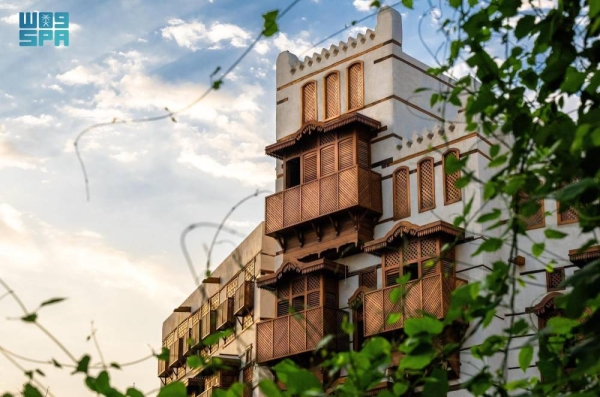The Jeddah Historic District Program, under the Ministry of Culture, is celebrating the 10th anniversary of Historic Jeddah’s UNESCO World Heritage List inscription in 2014. The program aims to preserve the cultural and urban heritage of the district and transform it into a global heritage destination in line with the Kingdom’s Vision 2030. The initiative recognizes the efforts of the Jeddah Governorate Municipality and the Heritage Commission in preserving the region’s heritage. Historic Jeddah, with its unique architectural, urban, and cultural features spread over 2.5 square kilometers, holds a significant location on the Red Sea coast. Acting as a major port for pilgrims and a hub for global trade, it has been a center for cultural and economic exchange since the seventh century.
Featuring over 650 heritage buildings, five main historical markets, historical mosques, and a historical school, Historic Jeddah stands out for its architectural style and urban fabric, reflecting the traditional construction methods of the Red Sea coast. The district’s inclusion on the UNESCO World Heritage List was due to its exceptional global value fulfilling three criteria: human values over time, developments in architecture and town planning, and its association with significant events, ideas, beliefs, or artistic and literary works. To further preserve and revitalize the area, the program has identified four key pillars: intangible cultural heritage, archaeology (including historic walls and gates), urban fabric (markets, squares, streets), and historical buildings (houses and mosques). These efforts aim to enhance the cultural and urban heritage of Historic Jeddah while creating a center for business and cultural projects, establishing it as a prominent tourist destination through infrastructure improvements and historical building restorations.
The Jeddah Historic District Program acknowledges the contributions of the Jeddah Governorate Municipality and the Heritage Commission in preserving the heritage of the region. Historic Jeddah, known for its unique architectural, urban, and cultural features spanning 2.5 square kilometers on the Red Sea coast, has been a center for cultural and economic exchange since the seventh century, serving as a major port for pilgrims and a hub for global trade between Asia and Africa. The district boasts over 650 heritage buildings, five main historical markets, historical mosques, and a historical school, all reflecting the traditional construction methods unique to the Red Sea coast. Its inclusion on the UNESCO World Heritage List was attributed to its exceptional global value fulfilling three criteria for human values over time, developments in architecture and town planning, and its association with significant events, ideas, beliefs, or artistic and literary works.
The Jeddah Historic District Program has established four key pillars to enhance the preservation and revitalization of Historic Jeddah: intangible cultural heritage, archaeology (including historic walls and gates), urban fabric (markets, squares, streets), and historical buildings (houses and mosques). By focusing on these areas, the program aims to preserve the cultural and urban heritage of Historic Jeddah while developing it into an attractive center for business and cultural projects. Through infrastructure improvements and the restoration of historical buildings, the program seeks to enrich visitors’ experiences and establish the region as a prominent tourist destination. The efforts are in line with the Kingdom’s Vision 2030, aiming to transform Historic Jeddah into a global heritage destination that preserves its unique architectural, urban, and cultural features for future generations.
The Jeddah Historic District Program, part of the Ministry of Culture, is celebrating the 10th anniversary of Historic Jeddah’s inscription on the UNESCO World Heritage List in 2014. The program continues its efforts to revitalize the district, aiming to preserve its cultural and urban heritage and transform it into a global heritage destination in line with the Kingdom’s Vision 2030. With the contributions of the Jeddah Governorate Municipality and the Heritage Commission, Historic Jeddah is renowned for its architectural style and urban fabric, characterized by multi-storey buildings, wooden components, and traditional construction methods unique to the Red Sea coast. The district’s inclusion on the UNESCO World Heritage List was due to its fulfillment of three criteria for exceptional global value: its human values over time, developments in architecture and town planning, and its association with significant events, ideas, beliefs, or artistic and literary works.
The Jeddah Historic District Program aims to enhance the preservation and revitalization of Historic Jeddah by focusing on four key pillars: intangible cultural heritage, archaeology, urban fabric, and historical buildings. These efforts are aimed at preserving the cultural and urban heritage of Historic Jeddah while developing it into an attractive center for business and cultural projects. The program seeks to enrich visitors’ experiences and establish the region as a prominent tourist destination through infrastructure improvements and the restoration of historical buildings. By preserving the unique architectural, urban, and cultural features of Historic Jeddah, the program is working towards transforming it into a global heritage destination that reflects the Kingdom’s Vision 2030 goals.


























